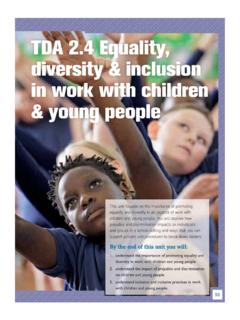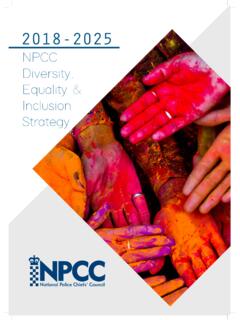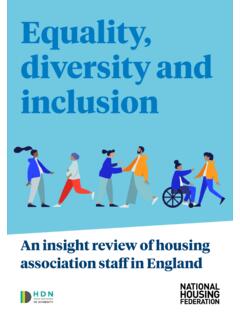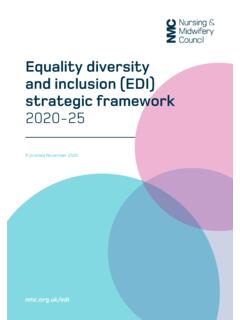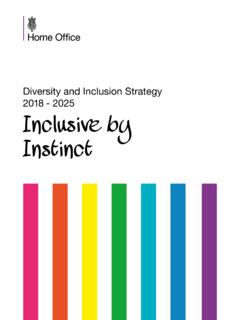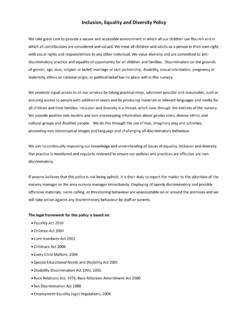Transcription of Equality, Diversity and Inclusion in Social Housing ...
1 equality , Diversity and Inclusion in Social Housing - Policy and Practice January 2016 2 Whilst the business case for equality , Diversity and Inclusion practice (EDI) is often implicitly referred to and recognised, the level of understanding and discussion within the sector as regards to the potential benefits of EDI good practice is somewhat more ambiguous. While the legal case and the moral case for EDI are typically accepted, the potential business case the benefits that EDI can bring to a Housing association, its staff, and tenants is of increasing importance in the current policy climate. This think piece comes at a time when Social Housing is high on the political agenda, with Housing Associations facing increased pressure to respond to rising demand against a backdrop of challenging Social Housing and welfare reforms.
2 These reforms have had financial consequences for Housing associations, and as a result many are making difficult decisions about how and where to invest resources to ensure the best possible business performance and sustainability. A good evidence base for the business case of EDI would undoubtedly inform decisions about the approach to take in the future. However, while the monitoring of equality and Diversity metrics, such as the demographics of Boards or staff, is becoming more commonplace, there has been little exploration of the impact and outcomes of good EDI practice. For example, can providing additional support for young people in Social Housing reduce the number of cases of antisocial behaviour that the Housing association has to deal with, and create more cohesive communities?
3 Do organisations that undertake activities to increase staff Diversity have better relationships with tenants as a consequence? Research on the impact of EDI is growing within the private sector, but there is a much more limited bank of evidence within Social Housing . However research currently being undertaken by CLES for Housing Diversity Network and sponsored by Places for People, Cestria and Aksa Homes will seek to evidence some of the benefits of EDI practice. The current policy paper explores the backdrop for this research: the current policy landscape and its impact on EDI and Housing associations, with an initial exploration of the potential benefits of equality , Diversity and Inclusion practice. 1. Introduction 3 At the national level the introduction of recent equality and Diversity reforms designed to improve equality in the workplace, have resulted in positive legislation such as a requirement to disclose the gender pay gap for all private and public sector organisations with more than 250 staff.
4 Reforms such as name-blind recruitment will introduce anonymous application forms across Undergraduate Courses at University and College, the organisation which processes applications to higher education, (UCAS) and other private and public sector organisations, in an effort to stop unconscious bias against potential recruits from black and minority ethnic (BME) backgrounds. Further legislation such as the equality Act 2010, the legalisation of gay marriage, and recognition of Islamophobia as a separate hate crime are likely to have a positive impact on groups in society that may be more likely to experience discrimination or disadvantage, according to protected characteristics1 such as disability, sexual orientation and race. Such reforms have provided Associations with important guidelines and a stronger foundation upon which to build their own initiatives and internal practices to ensure greater levels of equality and Diversity within their organisations.
5 In addition to this, the Social Value Act 2012 and associated agenda encourages those who commission and deliver public services, including Housing associations, to consider the wider Social , economic and environmental benefits that the service delivers. This is a clear opportunity to bring EDI to the forefront of service design: for example, an employment support service for residents that flexes provision to account for the relative disadvantage that job seekers with protected characteristics may face when seeking work has the potential to deliver greater Social value than one that does not. However, recent Housing policy reforms such as the reversal of the rental formula, which currently allows Housing associations to raise rents in line with the consumer prices index (CPI) (forming a significant part of their investment profile), has resulted in a 1 per cent cut to Housing association s annual funding.
6 Furthermore, the introduction of the recent Right to Buy scheme has further reduced Housing association s abilities to replace and or expand their stock, and manage their loan agreements due to the reduction in rent funding. The combination of such reforms has served to weaken the level of investment and funding available to associations resulting in greater financial pressures. In some cases this threatens the sustainability of their overall business model with implications for their equality and Diversity practices, both internally and across wider service delivery. 2. Policy Context 4 This is of particular concern given the wider austerity-driven policy context, and raft of recent asymmetric welfare reforms such as the Bedroom Tax , benefit cap and cuts to Housing benefit for young people, which have been found to disproportionately affect certain groups such as the black and minority ethnic (BME) communities who are already more likely to experience discrimination and disadvantage.
7 For example the extension of the benefit cap (which places a cap on the amount of benefits an individual is entitled to claim) has resulted in low income households facing a shortfall of 50 a week in more than one in six of England s 152 Housing districts, while disproportionately impacting single parent and large As a result the cap is more likely to impact women and BME groups who are overly represented within such groups3 4. Disabled tenants have also been affected by the closure of the Independent Living Fund and cuts to Personal Independence Payments5. While for people with severe disabilities the combination of cuts in benefits and services means that they lose an average of 8,832 per person, 19 times more than the burden placed on most other citizens6.
8 Women and families are also severely impacted by recent cuts, as the 13bn of cuts in Social security spending by 2020/21 will disproportionately hit families and women on low incomes, regardless of the rise in the minimum wage7. Members of the BME communities are similarly affected as BME tenants are more likely to be overrepresented in vulnerable groups; all BME communities display higher levels of unemployment and lower level of full time workers than the White British community, and as such are more likely to be affected by changes to tax credits and the introduction of the benefit cap8. The combination of such reforms are therefore likely to result in an increasing number of tenants and protected groups across the country being unable to afford their rent leading to an increased risk of homelessness and reduced spending on household essentials, particularly food and utility bills, which in turn may have serious mental and physical health implications for tenants9.
9 Such indirect impacts are likely to result in increased service demand, increased service delivery costs and a loss of income for Housing associations due to rent arrears and unstable or vacant tenancies. Combined with the 1% rent cut and Right to Buy reforms, associations are therefore facing reforms which pose both direct and indirect challenges to their financial sustainability. Housing Associations also face a number of future challenges from changing demographics within the population. For example the five largest distinct black and minority ethnic (BME) communities could potentially double from 8 million people or 14% of the population to between 20-30% by 205010. Housing Associations will therefore need to plan for delivering services and meeting the needs of communities 5 that will change significantly over time.
10 While the continued ageing population also presents a number of future implications for Associations such as the need to ensure that their Housing stock reflects the needs of an ageing population, coupled with the need for additional resources around health and Social care11. Housing Associations are therefore faced with several key challenges. In the short term, it is clear that the parts of the population that are usually the focus of EDI activity are more likely to be affected by changes brought about by welfare reform, potentially impacting on their need for services as well as ability to pay rent. In the longer term, changing demographics present a challenge that all service providers will need to respond to. However, these issues are in the context of a dramatically changed environment which has caused Housing Associations to fundamentally rethink their business plans and purpose and potentially limit their ability to respond to these challenges.
